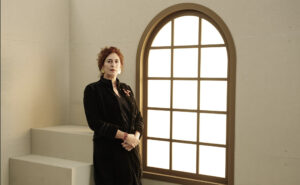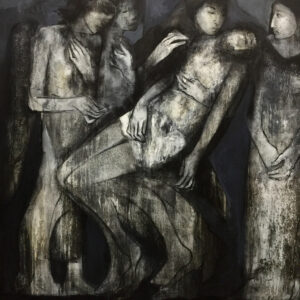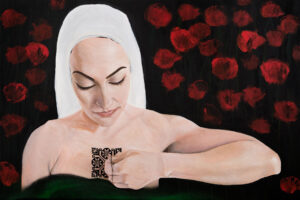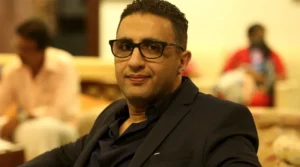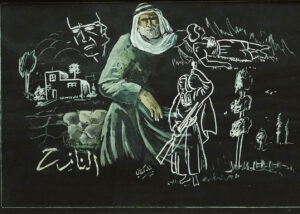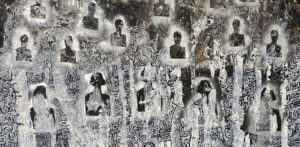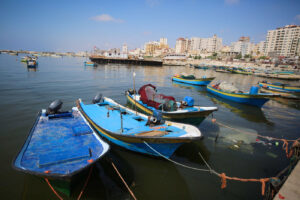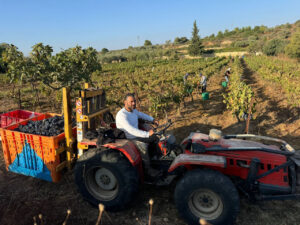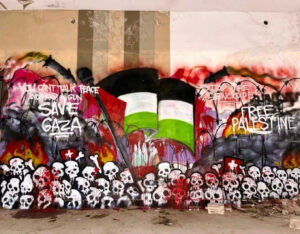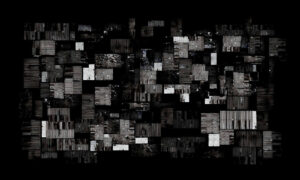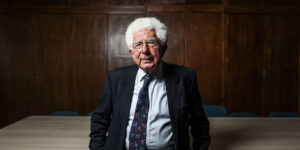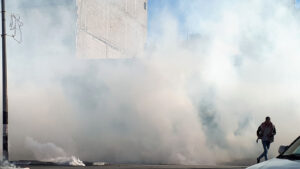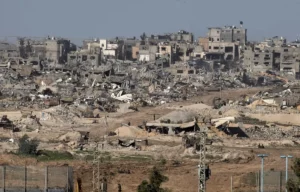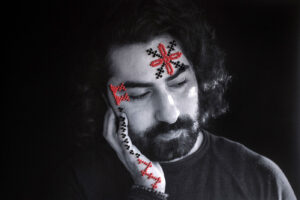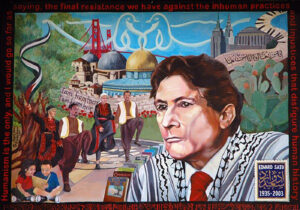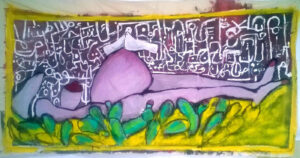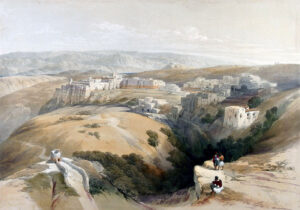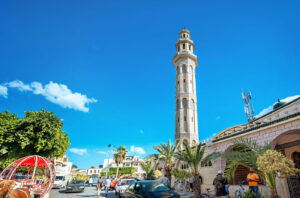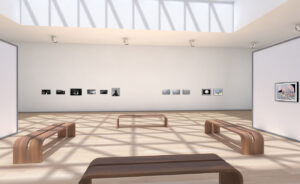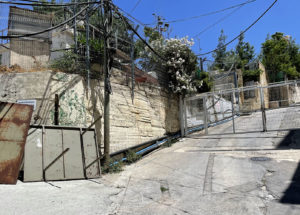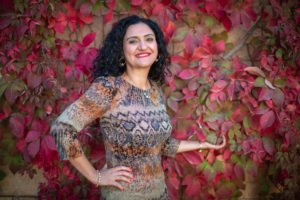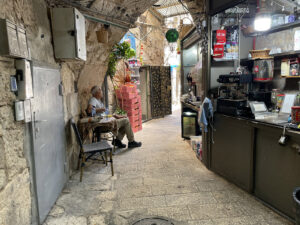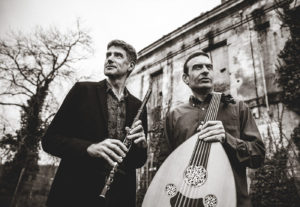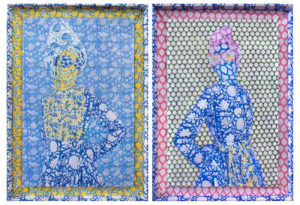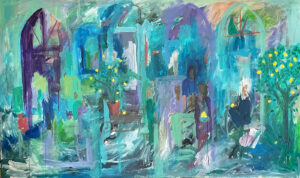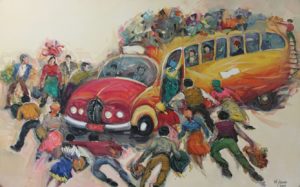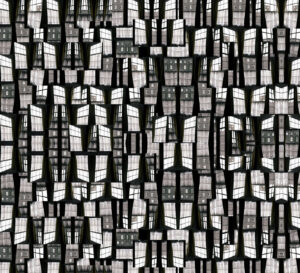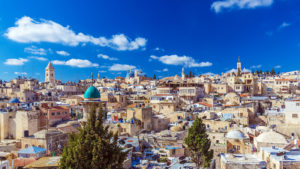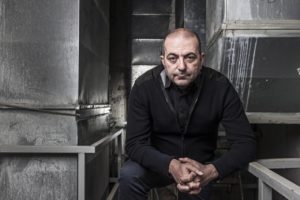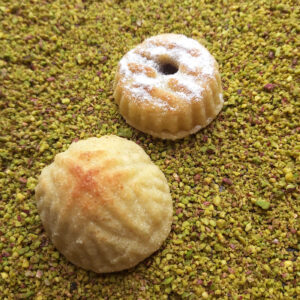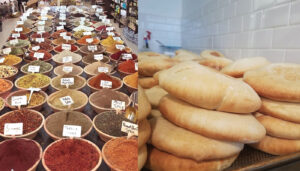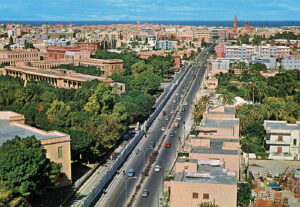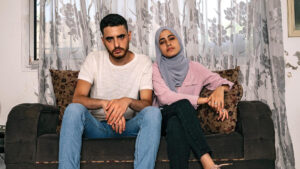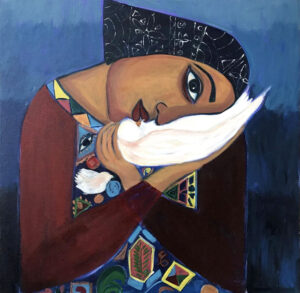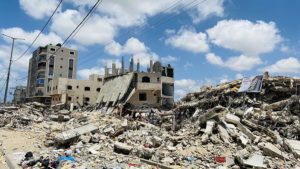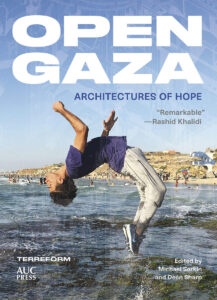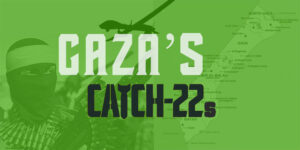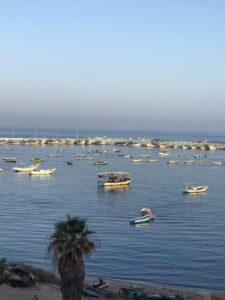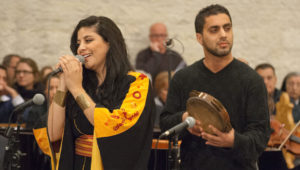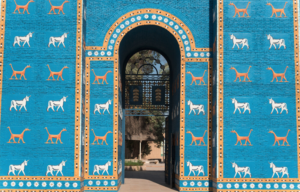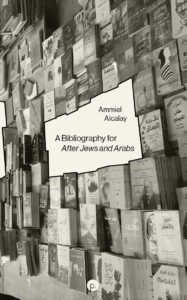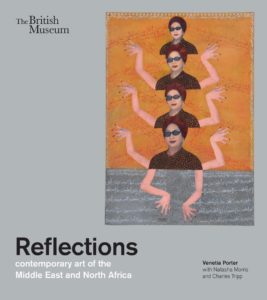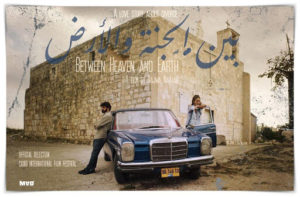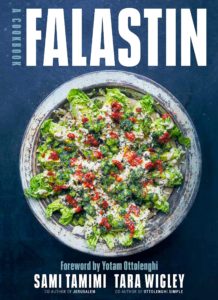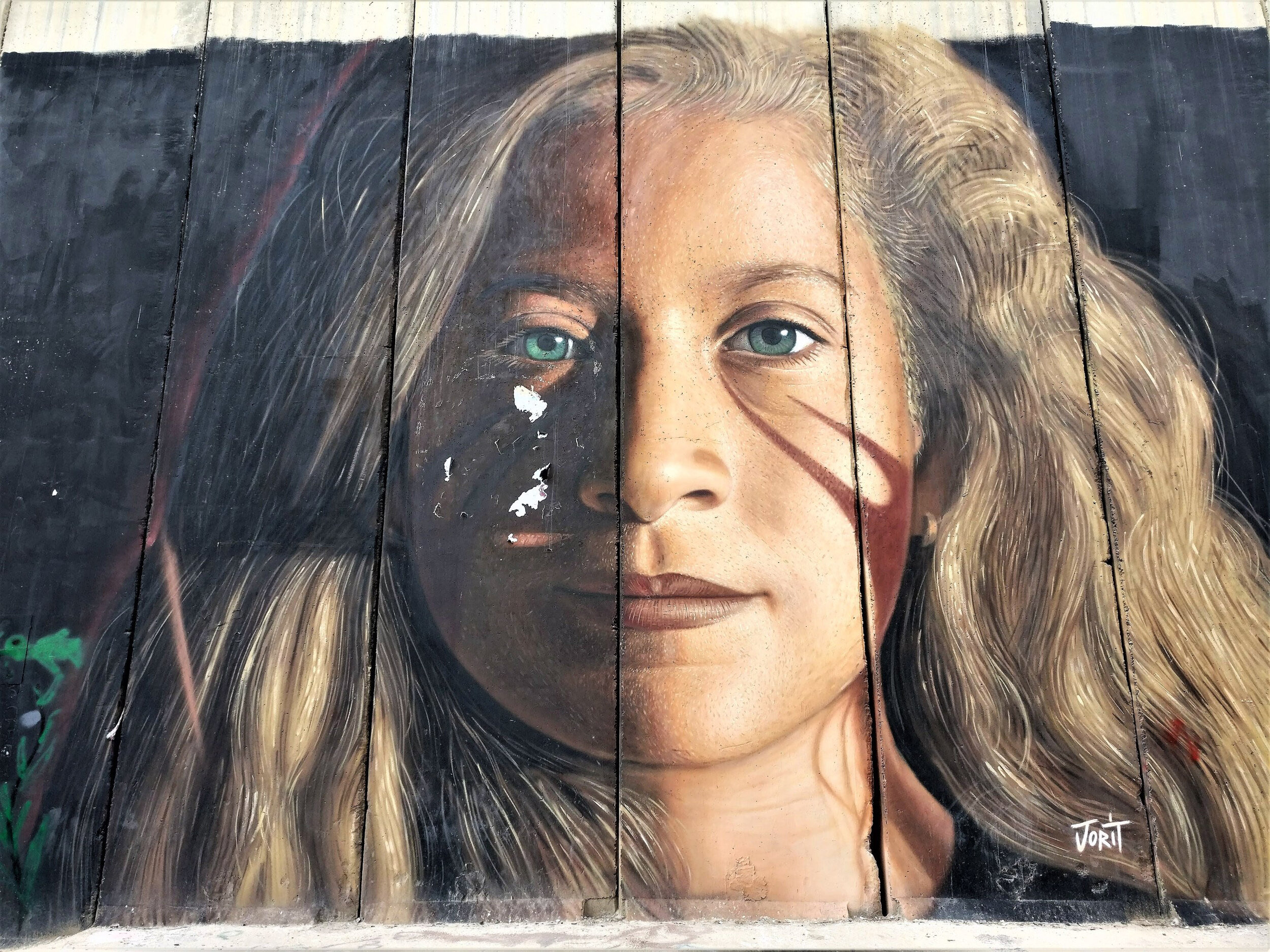
The Wall with a mural of activist Ahed Tamimi, who in 2017 was jailed for slapping an Israeli soldier. Italian street artist Jorit Agoch was later arrested for deifying Tamimi.
Malu Halasa
The Separation Wall, 700 kilometers long, is eight meters tall in some places and built of concrete; in others, it is deftly camouflaged behind shrubbery and trees. It incorporates barriers, electric fences, trenches, checkpoints, sensors and watchtowers. Behind the Wall, on the Israeli side, are additional fencing and razor wire, military patrol roads and sand paths for tracking footprints, all covered by surveillance cameras. This physical barrier between Israel and Palestine disrupts the views from either side as well as the possibility of interactions between people at ground level. Should a structure like this have any relationship to art or artists?
In 2005, British graffiti artist Banksy was spray-painting on the Separation Wall on the Palestinian side when an Israeli soldier interrupted him and asked: “What the fuck are you doing?”
Banksy replied that he would have to wait until it was finished, which prompted the soldier to inform his colleagues: “The safety’s off.” He was referring to the gun he was carrying. With the trigger unlocked, he could fire at will.
Minutes later, an elderly Palestinian man passed by and said to Banksy, “You paint the Wall, you make it beautiful.”
The Bristol graffiti artist mistook the remark for a compliment, and thanked the man. However, appreciation wasn’t the man’s intention. He quickly clarified: “We hate the Wall, we don’t want it beautiful. Go home.”
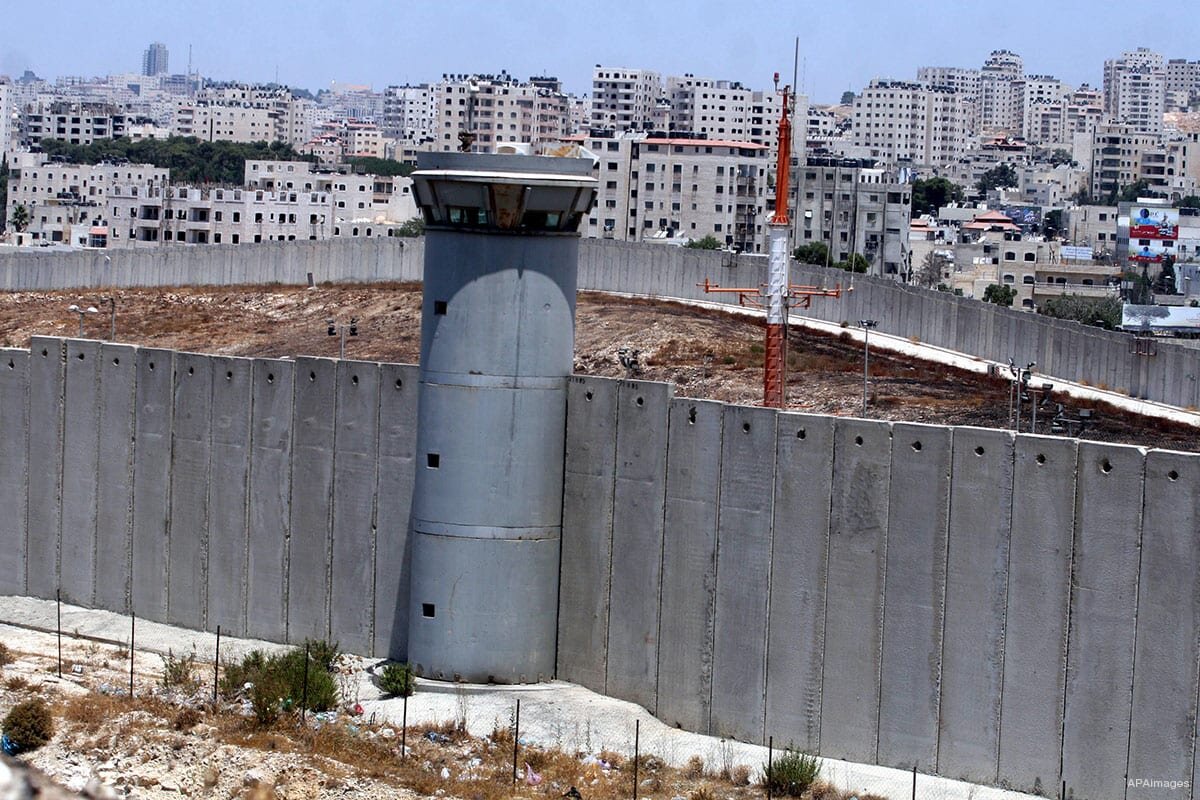
This brief but telling encounter, reported on graffiti-related websites including Banksy’s, encapsulate a bitter paradox. Here, occupier and occupied are in total agreement — albeit for different reasons. Neither the soldier nor the elderly man wanted an outsider using the Wall for his purposes, no matter how famous he might be.
The scene captures a strict political hierarchy that has become more intractable since 2005: an armed Israeli soldier controls Palestinian land, while the elderly Palestinian, ground down by years of disappointment and abuse, is disgruntled and disillusioned. Banksy’s involvement — then part of Santa’s Ghetto, a project with a group of graffiti artists — symbolizes the goodwill international artists have towards Palestine.
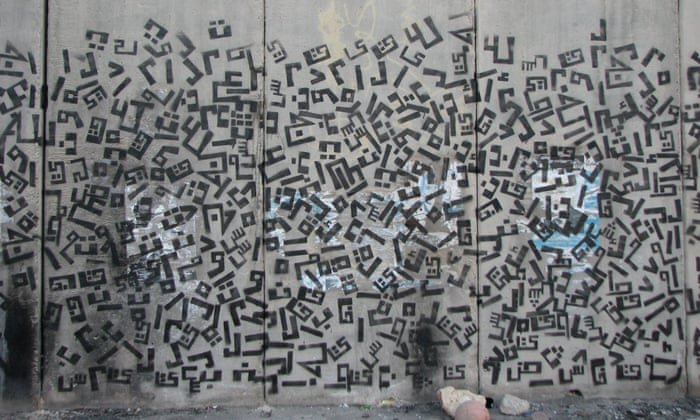
Palestinian artist Majd Abdel Hamid and two assistants spent 10 days painting a 14-metre long, 2-meter high portion of the wall in what appears to be a jumble of Arabic letters. Unscrambled, the letters spell out the Palestinian Declaration of Independence, written in 1988 by Palestinian poet Mahmoud Darwish.
The anecdote echoes a multifaceted faceted debate alive in the Palestinian arts community, which lies at the juncture of aesthetics, politics, and morality. When sections of the Wall were newly erected and it surfaces unblemished, Palestinians argued the relative merits of altering its appearance. In 2010, muralist Muhannad Al-Azzeh, a muralist on walls in Bethlehem refugee camps, argued for the constructed, pristine nature of the wall: “It’s a military color, and an ugly color, so keep it … ugly. I [would] not want to make this wall a beautiful thing.”
Others were more interested in the opportunity of a blank canvas like Majd Abdel Hamid. He plied the wall with an intriguing mash-up of words taken from the 1988 Palestinian Declaration of Independence, by poet Mahmoud Darwish. “This space is there,” said Abdel Hamid, “You have an opportunity to use it in a conscious way.”
For the 2012 Qalandiya International Biennale, with the theme: “Life and Art in Palestine,” Abdel Hamid scraped the Wall and gouged into it. The dust he collected was re-purposed into sands of time and placed inside three-hour glasses that the artist created through traditional Palestinian glass blowing methods. In effect, an embodiment of oppression had been transformed, refigured, and recycled into an object imbued with various interpretations. For some, the passage of time will heal all; for others, Palestine is a bridesmaid always waiting.
The Biennale, the first of its kind to be held in villages and towns across the West Bank and Gaza included other artworks with more dust from the wall. It was mixed with water, and formed into a soccer ball, for Concrete 2012 by Khaled Jarrar. Artists, both who use the wall as a canvas or feature its materiality in their work, face a quandary: Should oppression be witty or beautiful?
In her essay “Making an Ugly World Beautiful: Morality and Aesthetics in the Aftermath,” British critic and academic Dr. Sarah Edith James explored the hauntingly beautiful images taken by Western photographers during the 2003 Iraq War — the most heavily photographed war since the US war in Vietnam. As James wrote, “The radicality [sic] of the aesthetic projects of these photographers lies in their taking beautiful photographs of gruesome subjects…”
The beautiful/ugly debate encompasses earlier artworks such as Goya’s painting El Tres de Mayo, which takes as its subject the arbitrary executions of Madrid citizens during Napoleon’s 1808 invasion of Spain; Robert Capa’s The Falling Soldier, a reconstruction of a Spanish Civil War death, staged thirty miles from the place attributed in the photograph’s original title — Loyalist Militiaman at the Moment of Death, Cerro Muriano, September 5, 1936; and Picasso’s rendering of the bombing of Guernica, in 1937
This imagery is in sharp contrast to “the cheap current of 24-hour live coverage endless relayed to our living-rooms via the world’s news agencies and the spectatorship this promotes.” Replace “living-rooms” with computer screens and James’s ideas on voyeurism and consumption could equally be applied to the reporting on terrorism, the Separation Wall and Israel’s continuing assaults on Palestinians wherever they happen to be, in Gaza or at the time of writing this essay, Jerusalem.
No Exit through the Gift Shop
Twelve years after Banksy first painted the Separation Wall, in 2017, he designed with other creatives a boutique hotel in Bethlehem. The Walled Off Hotel, known for its gift shop and “the worst view in the world,” turned its hop, skip and a jump away from the Separation Wall into a selling point.
As Trip Advisor bookings poured in — current rooms range in price from $60 to $235 per night — local muralist Al-Azzeh reiterated his preference for the Wall’s raw ugliness to the Independent newspaper, in London.
“I want people to see an apartheid wall, a military wall. I don’t want them to discuss whether this painting is by Banksy, or whichever artist. I don’t want to forget all the Palestinian people killed there … when Israeli soldiers shot them.”
The hotel’s convenient location attracted international street artists like Lushsux from Melbourne. His kiss between Trump and Netanyahu provoked a negative reaction from conservative Palestinians. Another of his murals, showing American comedian Joe Rogan, with the text bubble: “Can you pull up that picture of me on the illegal border wall?” brought out activist Soud Hefawi, with his paints. He wrote in Arabic over it: “This is not a border wall. It’s an apartheid wall” and “Palestine is on both sides of the wall.”
The decoding of the scratch outs, re-writes and paint-overs on the wall has created a new area in academic studies.
Hefawi continued his fight on the blogosphere, where he questioned Lushsux’s “right” as “a colonialist to teach me how to fight colonialists!?”
Palestinians are upset and not just for historic reasons, as Walled Off Hotel manager Wisam Salsaa, explained to the website Aspiring City, “Locals don’t look at the wall the way internationals might see it. This means a lot to us because this wall has converted our towns and cities into an open-air prison. It’s prevented our towns from expanding. It’s limiting our movement. It’s been catastrophic for us as Palestinians.”
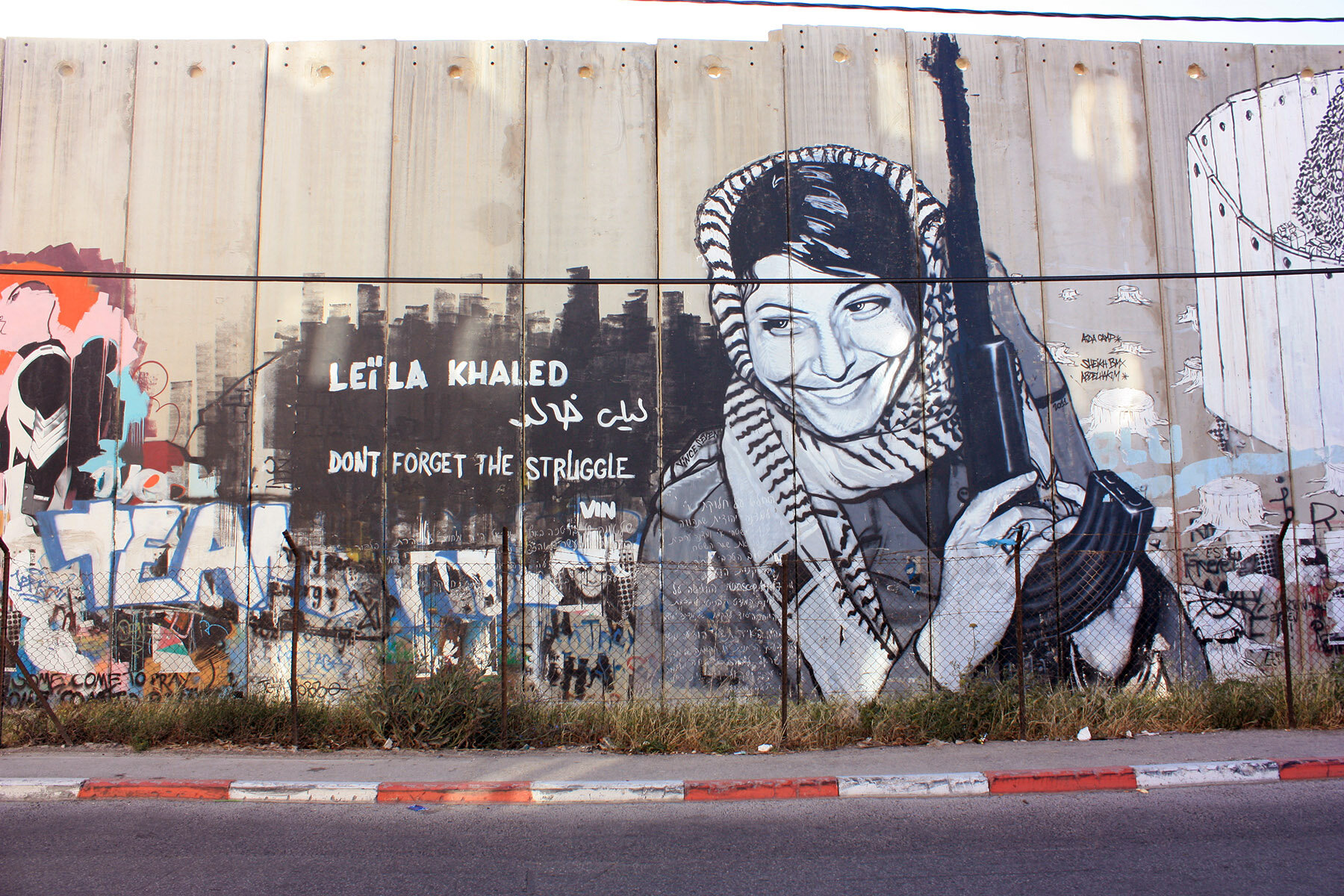
A mural of Leila Khaled, the first woman member of the Popular Front for the Liberation of Palestine. The photograph of her in a kaffiyeh holding an AK-47 rifle, taken by Eddie Adams, became a symbol of the Palestinian resistance in the 1970s. She was also the first woman to hijack a plane in the late 1960s, and has consequently gone down in history as both a hero and a terrorist. Her mural on the wall, near Bethlehem in the West Bank, is a staunch reminder of both the resistance’s past and its contested presence.
Buried Realities
For decades the invisibility of Palestinian art has been entwined with the erasure of Palestinian identity, first by colonial powers and then by Israel. Even Palestinian scholars have had a difficult time discussing the precursors of art in Palestine. For a long time, it was thought that the origins of Palestinian painting began in 1948. By the 1990s, the Palestinian painter and art historian Kamal Boullata (1942–2019) broke with his earlier claims to that effect, and traced the beginnings of painting in Palestine to seventeenth-century Arab Christian painters of religious icons. For Boullata, according to Columbia University’s Joseph Massad in his essay “Permission to Paint: Palestinian Art and the Colonial Encounter,” the year 1948 was “a partial rupture.” The schism between figurative and abstract painting was related to “the physical proximity to — and distance from — historical Palestine” as well as “the differing kinds of physical and spiritual exile experienced by all Palestinians, whether the five million who still live in the country — or the five million living outside it and prevented from returning to it by the Israeli state …”
In his master’s thesis Reconsidering the Value of Palestinian Art & Its Journey into the Art Market for the Sotheby’s Institute of Art, Palestinian artist and photographer Steve Sabella wrote that by the 1990s, art from the Occupied Territories had “shifted from collective symbolic, illustrative, figurative and narrative expression” characteristic of older generations of artists “to more individual or personal expression.” Despite this change in focus, “place” or “homeland” remains vitally important to all Palestinian artists.
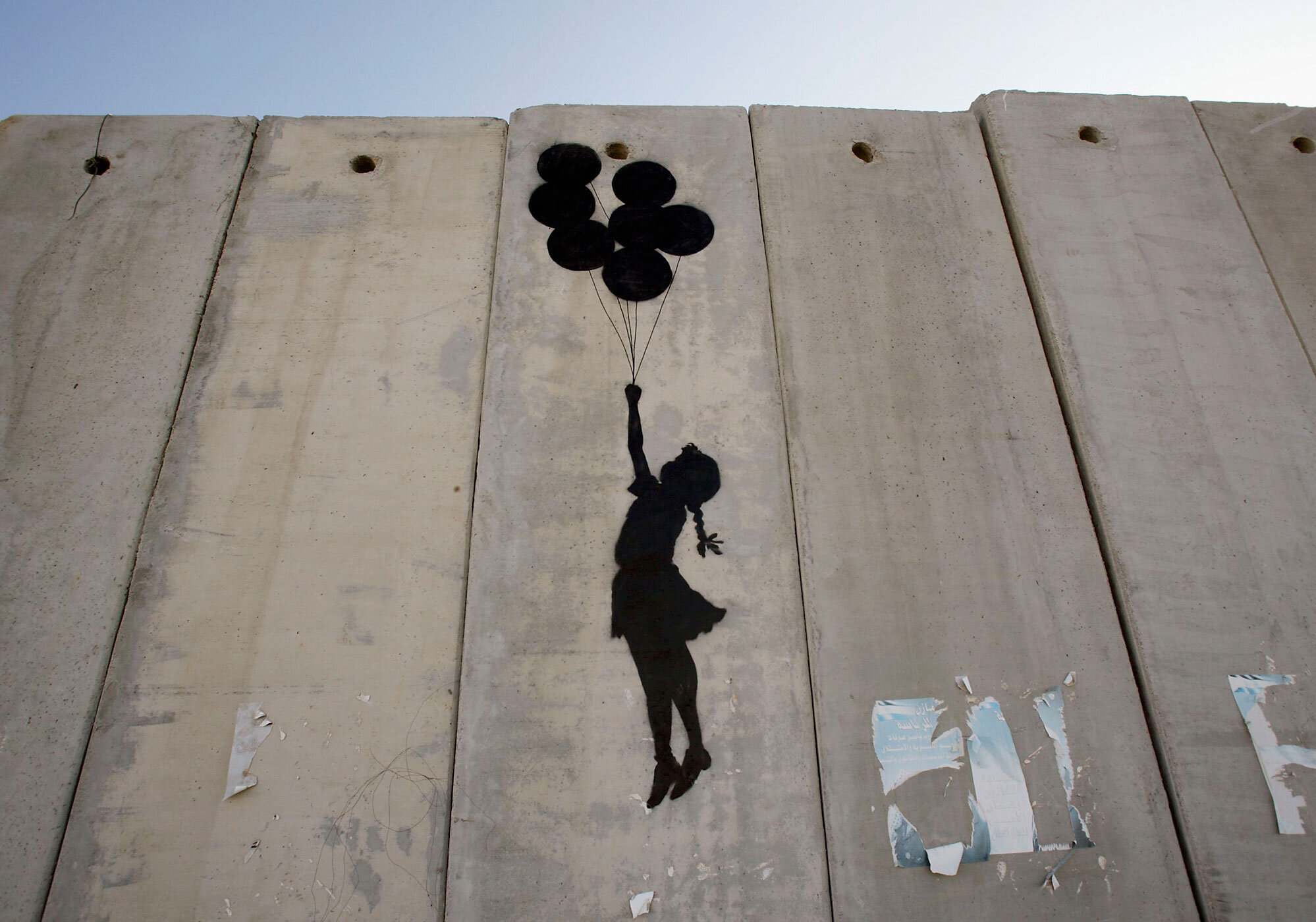 1. Banksy’s balloons on the Separation Wall at the Qalandiya checkpoint.
1. Banksy’s balloons on the Separation Wall at the Qalandiya checkpoint. 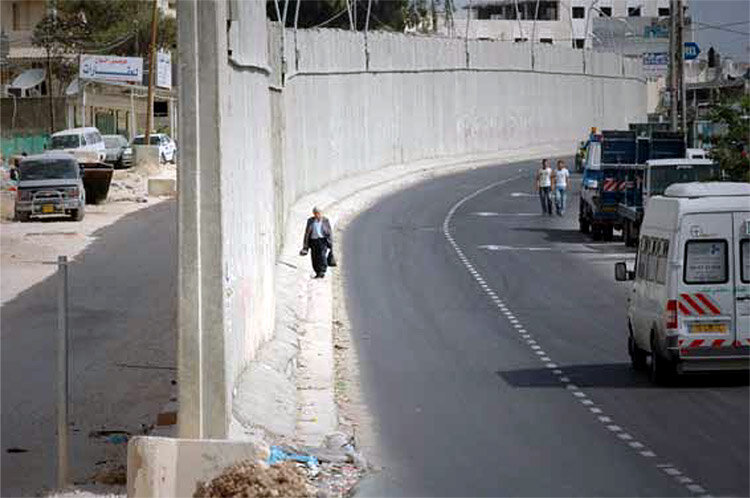 2. The eight-meter Separation Wall built by Israeli cuts through the heart of East Jerusalem.
2. The eight-meter Separation Wall built by Israeli cuts through the heart of East Jerusalem. 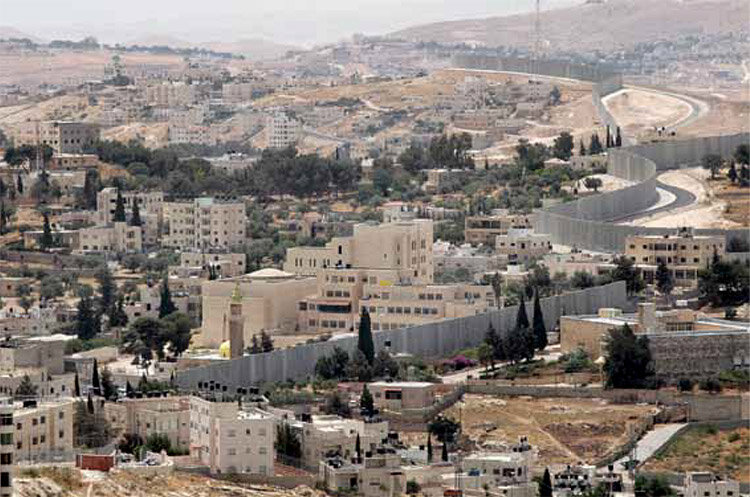 3. The Separation Wall zigzags around neighborhoods in East Jerusalem, and separates Palestinians from other Palestinians
3. The Separation Wall zigzags around neighborhoods in East Jerusalem, and separates Palestinians from other Palestinians
Sabella quoted Boullata: “Wherever they live … Israel’s Separation Wall and its military checkpoints have entered their art as their language continues to cross barriers between exile and memory, identity and gender, displacements and fragmentations. Some have continued to find their expression in painting whereas others went on to explore new tools and media. Together, their work gives body to an art of resistance that never ceases to inspire.”
For the thesis, Sabella included his photographs of the Wall, from 2005–06. His photographs’ unmediated view of ordinary Palestinians making their way around a snaking, concrete river that divides seemingly run-of-the-mill city blocks or districts only enhances the abnormality of the situation. Sabella’s images recall James’s evaluation of the beautiful within the horror of the Iraq war: “So that an aesthetics of sublimity serves not to transcend violence but collapse into it, promoting a strange revelation or reflection on the real that would be other-wised buried.”
Artistic Defiance
Creative resistance and artistic dissent came into sharp relief during the 2011 “Arab Spring” mass uprisings. Professor Charles Tripp, a professor of politics at the School of Oriental and African Studies, at the University of London, has been researching the ways in which art can shift relationships of power, first by manifesting as forms of defiance and then by mobilizing these to eventually diminish power itself. He observed in his lecture On Art and the Arab Uprising that art was at its most effective during the 2011 uprisings when it challenged power openly, in public space. By doing so it not only generated a sense of common purpose, it also identified an engaged community — and in the process it radically changed perceptions of who should be in charge. Similar questions arise when standing by Israel’s Separation Wall.
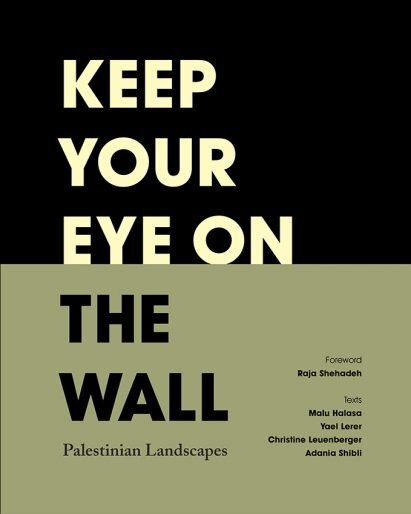
“How does art defy or disrupt the hold of power itself?” Trip asked. “First by contesting the public face of power — going out and physically defacing the dictator’s image. Second. How do you undermine the authority of power? Although it is very difficult to ensure … there is the slow drip-drip of artistic defiance.” He argued that one way to gauge the effectiveness of this kind of art was to observe the reaction of the powers-that-be. In the case of Palestine, he said, “The very act of producing art under occupation and military retaliation is resistance.” At key junctures, the Israeli authorities have reacted badly — witness, for example, the 2002 ransacking of the archives, documents and art collection of the Khalil Sakakini Cultural Centre in Ramallah by Israeli soldiers during the Second Intifada and the blockade of Yasser Arafat’s compound.
Another example, cited by Tripp, was Vera Tamari’s installation of cars wrecked by Israeli tanks. (It seemed that Israeli tanks purposely rolled over parked cars in the streets and in people’s driveways, again in 2002, leaving a trail of sideswiped and crushed vehicles.) The artist assembled the wrecks on an asphalt road placed in a field outside Ramallah for her installation Going for a Ride.
When passing Israeli tanks mauled the cars in the installation for a second time — the soldiers even stopped long enough to urinate on them — Tamari had recorded the incident on video, footage that was added to the installation.
Beauty can be terrifying and visionary. As the French philosopher Jacques Rancière wrote in The Politics of Aesthetics, the “aesthetic acts as configuration of experience that create new modes of sense perception and induce novel forms of subjectivity.” Art and photography from Palestinian serve this purpose.
The debate over the value of representing oppression in art or leaving it alone in the name of resisting normalization is useful and necessary. However, for artists inside and outside the region it is not possible to remain neutral. Those who elect to paint and write on the Wall or include its materiality in their artworks provoke reflection on questions about power and its prerogatives. Given the choice, they seem to ask, where would you prefer to live? On one side or another of an impossibly high concrete wall or in a place where fruitful dialogues between neighbors are possible, and separation walls no longer exist?
An earlier version of this essay appeared as “Oppressive Beauty: Against Aestheticising the Wall” in Keep Your Eye on the Wall: Palestinian Landscapes, the anthology edited by Olivia Snaije and Mitch Albert, published in French by Éditions Textuel; and in English by Saqi Books, in 2013.




